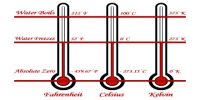A clinical thermometer is a sensitive Fahrenheit scale thermometer. For measuring the temperature of the human body this thermometer is extensively used. For this reason, this thermometer is called clinical thermometer or doctor’s thermometer.
A clinical thermometer is a tool for measuring body temperature. They are available in the ear, rectal, armpit, forehead and oral models.

Construction: It consists of a cylindrical bulb B which is filled with mercury. A capillary tube T of uniform and a fine bore is attached to the bulb. Just above the bulb at point C, the tube is made narrow and bent. Since the temperature of the human body varies from 95°F to 110°F, the thermometer is calibrated in this temperature range. Each degree is divided into five small equal divisions. Besides, as the temperature of a healthy man is 98.4°F, so special bold or red mark is made on the surface of the thermometer at 98.4°F.
The normal temperature in a clinical thermometer is from about 35 degrees to 42 degrees. The temperature of a healthy human body is approximately 98.6°F. To determine the temperature a person has to hold the tip of the thermometer either under the armpit or in the mouth under his tongue for a minute. Then we monitor the number against the point at which the mercury line stop growing further indicates the body temperature of the person.
Working Principle: The thermometer is thoroughly shaken before measuring the temperature of the body. Then the mercury level drops and remains inside the bulb. In this condition, if the thermometer is placed under the tongue or under the arms, the temperature and consequently the volume of the thermometer increases. As a result, some mercury flows through the capillary tube C from the bulb B. When the thermometer is taken out of the body, the mercury level contracts. Consequently, the mercury above level C goes back to the bulb. But since the mercury level above C cannot come back to the bulb through the fine capillary tube, it remains above C. So the upper level of the mercury surface indicates the temperature of the body. Before using the thermometer again it should be shaken thoroughly so that mercury level goes back to the bulb.
Even after the thermometer removed from the body. The temperature can be read. Since it is measured the highest temperature of a body. So it is called maximum thermometer.
Structure:
- It is smaller in size than the laboratory thermometer.
- It has a constriction in the fine capillary tube. This enables the recording of the utmost temperature of the body without the need for haste.
- The mercury thread needs to be shaken back into the bulb before the thermometer is used again.
Range:
- The scale ranges between 35°C to 42°C.
- This range is centered on the normal body temperature of 36.9°C.
- Short range enables the scale to be divided into smaller intervals for bigger accurateness (0.1°C).
The classification of the thermometer, such as oral or armpit, affects its features.
- Mercury-filled thermometers. In addition to not being the main correct, they might be very dangerous if broken. The mercury inside is toxic to people and the environment.
- Alcohol-filled thermometers. A safer alternative to the previous type, these thermometers use colored alcohol that expands when exposed to increased temperature.
- Temperature Strips. Although temperature strips are not thermometers per sec, they are often used in hospitals as a way of rapidly formative a patient’s temperature.
- Infrared thermometers. This type is regularly used to find out the person’s temperature through their ear.
- Digital thermometers. Digital thermometers are rapidly replacing all of the old liquid-in-glass versions. They are fast, correct and suitable.
- Basal thermometers. Even though they are only a form of digital thermometer, they are still dissimilar. This type is meant for women that are trying to get pregnant.















